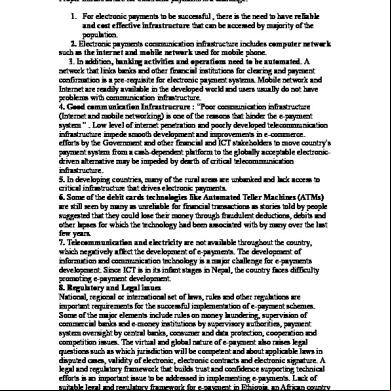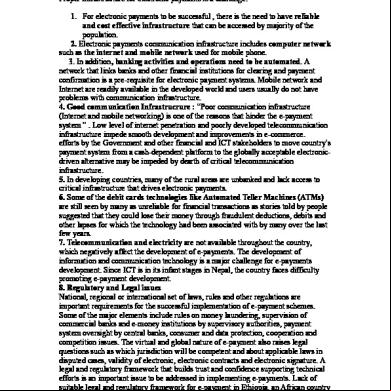Infrastructure Issues In Eps (1) 2w734
This document was ed by and they confirmed that they have the permission to share it. If you are author or own the copyright of this book, please report to us by using this report form. Report 3b7i
Overview 3e4r5l
& View Infrastructure Issues In Eps (1) as PDF for free.
More details w3441
- Words: 676
- Pages: 2
Infrastructure Issues in EPS Infrastructure is necessary for the successful implementation of electronic payments. Proper Infrastructure for electronic payments is a challenge. 1. For electronic payments to be successful , there is the need to have reliable and cost effective infrastructure that can be accessed by majority of the population. 2. Electronic payments communication infrastructure includes computer network such as the internet and mobile network used for mobile phone. 3. In addition, banking activities and operations need to be automated. A network that links banks and other financial institutions for clearing and payment confirmation is a pre-requisite for electronic payment systems. Mobile network and Internet are readily available in the developed world and s usually do not have problems with communication infrastructure. 4. Good communication Infrastrucrure : “Poor communication infrastructure (Internet and mobile networking) is one of the reasons that hinder the e-payment system ” . Low level of internet penetration and poorly developed telecommunication infrastructure impede smooth development and improvements in e-commerce. efforts by the Government and other financial and ICT stakeholders to move country’s payment system from a cash-dependent platform to the globally acceptable electronicdriven alternative may be impeded by dearth of critical telecommunication infrastructure. 5. In developing countries, many of the rural areas are unbanked and lack access to critical infrastructure that drives electronic payments. 6. Some of the debit cards technologies like Automated Teller Machines (ATMs) are still seen by many as unreliable for financial transactions as stories told by people suggested that they could lose their money through fraudulent deductions, debits and other lapses for which the technology had been associated with by many over the last few years. 7. Telecommunication and electricity are not available throughout the country, which negatively affect the development of e-payments. The development of information and communication technology is a major challenge for e-payments development. Since ICT is in its infant stages in Nepal, the country faces difficulty promoting e-payment development. 8. Regulatory and Legal issues National, regional or international set of laws, rules and other regulations are important requirements for the successful implementation of e-payment schemes. Some of the major elements include rules on money laundering, supervision of commercial banks and e-money institutions by supervisory authorities, payment system oversight by central banks, consumer and data protection, cooperation and competition issues. The virtual and global nature of e-payment also raises legal questions such as which jurisdiction will be competent and about applicable laws in disputed cases, validity of electronic, electronic contracts and electronic signature. A legal and regulatory framework that builds trust and confidence ing technical efforts is an important issue to be addressed in implementing e-payments. Lack of suitable legal and regulatory framework for e-payment in Ethiopia, an African country is a challenge. Ethiopian current laws do not accommodate electronic contracts and signatures. Ethiopia has not yet enacted legislation that deals e-payments and ecommerce concerns including enforceability of the validity of electronic contracts,
digital signatures and intellectual copyright and restrict the use of encryption technologies. National regulatory and legal framework that aligns with regional and international agreements is crucial in creating a certain and reliable environment. Adopting model laws at the global level such as UNCITAL Model law on e-signatures can help the purpose. 9. Socio-Cultural Challenges Cultural and historical differences in attitudes and the use of different forms of money (e.g. use of credit card in North America and use of debit cards in Europe) complicate the task of developing an electronic payment system that is applicable at international level . Difference in the degree of the required security and efficiency among people of different cultures and level of development aggravates the problem. Consumer’s confidence and trust in the traditional payments system has made customers less likely to adopt new technologies. New technologies will not dominate the market until customers are confident that their privacy will be protected and adequate assurance of security is guaranteed. New technologies also requires the test of time in order to earn the confidence of the people, even if it is easier to use and cheaper than older methods.
digital signatures and intellectual copyright and restrict the use of encryption technologies. National regulatory and legal framework that aligns with regional and international agreements is crucial in creating a certain and reliable environment. Adopting model laws at the global level such as UNCITAL Model law on e-signatures can help the purpose. 9. Socio-Cultural Challenges Cultural and historical differences in attitudes and the use of different forms of money (e.g. use of credit card in North America and use of debit cards in Europe) complicate the task of developing an electronic payment system that is applicable at international level . Difference in the degree of the required security and efficiency among people of different cultures and level of development aggravates the problem. Consumer’s confidence and trust in the traditional payments system has made customers less likely to adopt new technologies. New technologies will not dominate the market until customers are confident that their privacy will be protected and adequate assurance of security is guaranteed. New technologies also requires the test of time in order to earn the confidence of the people, even if it is easier to use and cheaper than older methods.










